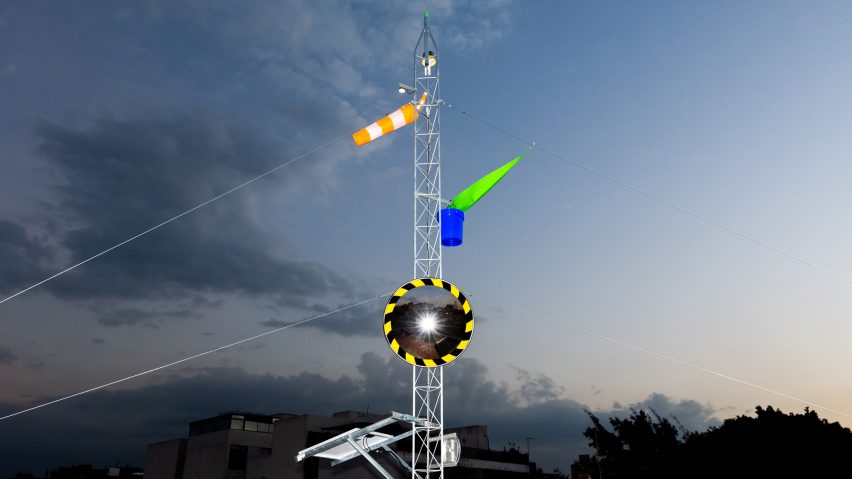Mexican design office Departamento del Distrito has created a totem equipped with solar power that produces light, plays music, measures the weather and cools down the air on a Mexico City rooftop.
The seven-metre-high installation, titled When Models are Systems, consists of a repurposed telecommunications mast installed on the roof of a former lace factory that is now a cultural centre.
The structure integrates an 85-watt photovoltaic panel, linked to a generator and battery, which allows it to harness and store solar energy.
This is used to power various electronic devices, including spotlights, a mist cooling system and loudspeakers synced to a curated music playlist.
Departamento del Distrito founders Francisco Quiñones and Nathan Friedman have also added other elements, so that the tower can become an information point as well as a gathering place.
These elements include a thermometer, an air-humidity monitor, a wind sock, a digital clock, a tarp and bucket for collecting rainwater, a mirror for reflecting light, and a lightning rod for grounding electrical currents.
"The atmospheric products of the tower are active for a finite period of time each day, determined by the amount of [solar] energy that is produced and stored," said Quiñones and Friedman.
"Taking advantage of the rainy season in Mexico City, which spans late May through November, the project is dependent on the periods of intense morning sunshine and afternoon thunderstorms that are typical during these months."
When Models are Systems is one of six installations produced by winners of the Architectural League Prize 2022, an annual award granted by the Architectural League of New York.
Previous winners were asked to present works in a gallery but, since the pandemic, designers are now instead asked to create an installation in their home city.
Quiñones and Friedman saw this as an opportunity to engage with the politics of energy and climate policy in Mexico, which they describe as "an urgent and contemporary concern for the population at large".
"Despite Mexico's immense potential for solar energy production, the current federal administration has prioritised national hydrocarbon industries and broadcast its agenda through a new state-run oil refinery, currently under construction in Dos Bocas, Tabasco," they told Dezeen.
Their design aims to promote the social and economic benefits of renewable energy in a playful way.
Visitors have engaged with the structure in various ways, according to Quiñones and Friedman, with some simply coming to charge their mobile devices while others are using it as a social space and engaging with the ideas behind it.
"When you encounter the installation, the climate discourse that motivated it is not immediately obvious," explained the designers. "This is intentional."
"First and foremost, it needs to be able to stand alone as a work that is joyful, well-executed, and has the capacity to bring people together. Then, if you want to engage with the politics, the discourse is there."
The installation is temporary so will be removed at a later date to make room for new artist studios that are set to be built in its place.
The modular nature of the design means it could be potentially reassembled elsewhere, creating a solar-powered social space in a new location.
The photography is by Adriana Hamui.
Project credits
Design: Departamento del Distrito
Team: Francisco Quiñones, Nathan Friedman, Alfonso Peláez Rovalo
Technical consultant: ESYSTEC México
Support: Architectural League of New York, Rice Architecture
Solar Revolution
This article is part of Dezeen's Solar Revolution series, which explores the varied and exciting possible uses of solar energy and how humans can fully harness the incredible power of the sun.

